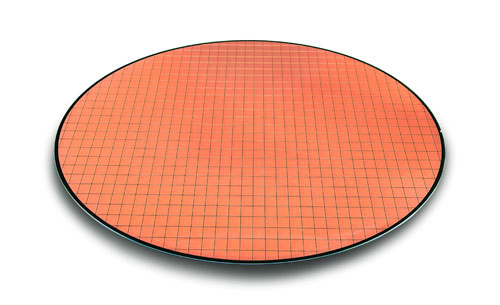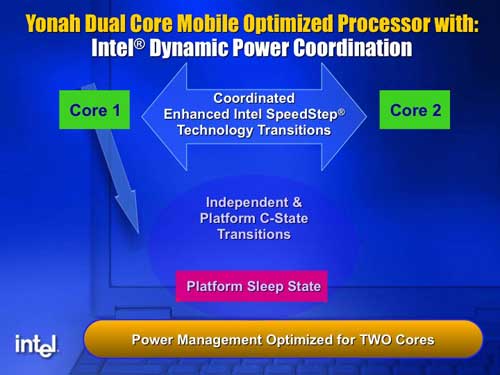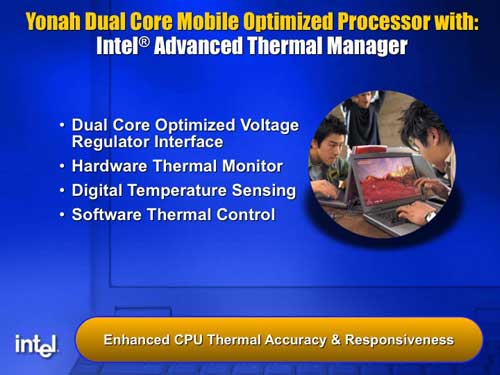Intel's Core Duo Launch - Notebook Performance Revealed
by Anand Lal Shimpi on January 5, 2006 8:00 PM EST- Posted in
- Laptops
CPU-Level Power and Thermal Enhancements
Back in March Intel's Mooly Eden told us that despite the move to two cores and almost doubling the transistor count of Dothan, Yonah notebooks would offer battery life no shorter than Dothan notebooks. In other words, you'd get all of the performance benefits of dual core but with no power consumption penalty.
While we noted that, at least on the desktop side, both the Athlon 64 X2 and Pentium D provided us with dual core performance but with only an additional 15% increase in power consumption. So it wasn't too far fetched to believe that, with enough effort, you could move to dual core, increase performance and not increase power consumption.
At the same briefing where they told us that they would keep power consumption the same, Intel also told us how they'd do it:
From the first time we heard the name Yonah we knew that its designers would be introducing some interesting power management technologies. While we don't normally like filling articles with quotes, here's one from Mooly today that is a great segue into this section:
"Yonah battery life will not be shorter than Dothan battery life...[it's] a huge achievement"
Given that Yonah will have twice the decode/execution transistors of Dothan, offering equal battery life for Yonah notebooks is a pretty impressive claim.
Mooly went through some of the power management technologies in Yonah that Intel is calling Dynamic Power Coordination. The idea is this - there are some areas where you can have each core operate independently with regards to reducing power consumption, but other areas where you can't.
Dothan has five operating states:
C0 - full power
C1 - auto halt (less power)
C2 - stop clock (even lower power)
C3 - sleep (lower power)
C4 - deep sleep (still lower)The CPU's goal is to complete the tasks it's given, while always striving to be in as low of a power state as possible. So for example, if a Dothan is running an application that doesn't require full performance, it can operate in one of the lighter power saving states until it is done working, then eventually drop all the way down to C4.
The lighter power saving stages just do things like reduce clock speed or gate the clocks to parts of the chip, these types of things can be done independently on each core in Yonah (e.g. one core can be in C1 while the other core is in C0). Once you get down to adjusting voltage and playing with the PLL, then the two cores can't act independently - since they are both fed the same voltage and clock signal. Here is where Intel's Dynamic Power Coordination comes into play; if one CPU wants to go to a lower power state (e.g. C3 or C4) but the other core is running at C0, it will inform Intel's DPC logic of the current situation. Intel's logic, as you would expect it to act, will wait until the core running in C0 is done working and then move both cores down to the lower power state. Synchronization like this is important and it helps keep power consumption down to a minimum.
Because of the power management that is needed for Yonah, the two cores have to always work closely together to make sure that they are aware of each other's power state desires - for this reason alone Yonah is already much more than a pair of Dothans with a shared cache.
Yonah also introduces finer grained thermal management through what they are calling the Advanced Thermal Manager. With dedicated digital thermal sensors in each core, each with a higher accuracy, the temperature data the CPU can feed the rest of the system is more accurate in Yonah than in previous generation Pentium M CPUs. Although Mooly didn't talk about it here, you can expect that the thermal management technology in Yonah will allow for one core to be slowed down independently of the other if power consumption or heat dissipation rises too much.
The one item that isn't mentioned, but is quite responsible for the excellent thermal and power characteristics of Intel's Core Duo is the 65nm manufacturing process it is built on.

A Yonah wafer
Intel's 65nm process is ramping up nicely and is extremely cool running and very low power. Combine it with the power management technologies talked about above and you can see how the move from Dothan to Yonah wouldn't negatively impact power consumption.












29 Comments
View All Comments
Shark Tek - Thursday, January 5, 2006 - link
Lets hope that AMD release Turion's X2 with a even more reduced power consumption and DDR2 support that will be really "Sweet".Se imaginan un Turion64 X2 o un Core Duo combinado con un x1800 Mobility Radeon eso seria la combinacion perfecta para 'Lan Parties'. Sin la necesidad de andar con equipo pesado.
==============================================================================
Can you imagine a notebook with Turion X2 or Core Duo matched with a X1800 Mobility Radeon. That will be the perfect combination for Lan-Parties. Without the need for carrying heavy parts from your Desktop @ home.
Just imagine that ....
coldpower27 - Thursday, January 5, 2006 - link
Very impressive.monsoon - Thursday, January 5, 2006 - link
yeah, me too i'm curious about the Apple products coming with Yonah, and how they stack up to X2 athlons PC Yonah notebooks......and overclocking !!!
PS - BTW did you try to overclock the ASUS Yonah notebook ?
PeteRoy - Thursday, January 5, 2006 - link
noDoormat - Thursday, January 5, 2006 - link
Page loads took forever but the review was interesting.I'm still interested to see what Apple does with these chips in their iBooks next week.
The battery life of the T60 was impressive - 227 minutes for DVD playback. Finally, I can watch an LOTR episode on one battery!
The release of only 1 single core chip speaks volumes - intel is ditching single core chips when they can. They want to push dual core hard.
Calin - Friday, January 6, 2006 - link
In DVD playback the DVD unit consume some of the power... I wonder if playing a DVD from a virtual drive or from a network would prolong battery lifeFuren - Thursday, January 5, 2006 - link
Very lovely power consumption. I suppose power consumption will be a bit higher when both cores are at 100% usage but most of us dont keep our CPU usage pegged at 100% when using a notebook and specially not if we care about power consumption at all. It'd be nice if Intel had decided to go to 90nm on the chipsets but I suppose their power consumption is not that high to begin with and Intel needs a use for its 130nm fabs...Calin - Friday, January 6, 2006 - link
off course the power consumption will be higher with both cores at 100% usage - but in this case the "work per watt" is greater, as processors don't use all the power in the system.Just that people would prefer a laptop that consume a battery charge faster but finish the work much faster than the other way around.
cheburashka - Thursday, January 5, 2006 - link
Intel's chipset shortage problem is because all current MCH's are still on 130nm, which is maxed out in the fabs. They would love to get the 90nm Broadwater/Crestline chips out the door to free up 130nm capacity to build low end parts again.